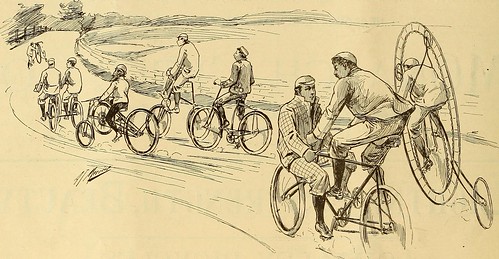 Road Rash and Ramen Noodles: True Tales of Pro Cycling on $10 Dollars a Day by Phil Gaimon
Road Rash and Ramen Noodles: True Tales of Pro Cycling on $10 Dollars a Day by Phil GaimonMy rating: 3 of 5 stars
The first odd thing about this is that the print edition I read had the title that the Kindle edition carries, Pro Cycling on $10 a Day: From Fat Kid to Euro Pro. Both editions are from Velo Press. This seems . . . odd.
Gaimon blogs for VeloPress, for example this blog post. Having read a few of these, I was hoping for an enjoyable reading experience and I was a little let down by what I found, thus three stars.
I am a long time bike commuter and I have the usual too-many-bikes and even blog about cycling history myself but I realize that my interest in professional bicycle racing these days is pretty low. I was more interested a few years ago, but unlike those who were turned off by doping, I am turned off by the adoption of new bicycle technology and parts that are clearly I will never adopt, I suppose largely because of the cost but also because the marginal gains are so small. And yet I still look at VeloNews many days of the week and read a few stories and vaguely follow some of the big stage races. So one question is why I even read a book like this - I guess because bicycle racers are the most noticed practitioners of cycling in our society and because I have read a number of such books and enjoyed some of them in the past.
Phil Gaimon is now a rider for Garmon-Sharp. The book (memoir?) in an autobiographical account of what it took to get to that point, including a longer-than-usual amount of time in what amounts to the minor leagues of cycling before arriving in the big leagues.
Right at the start, Gaimon announces he is clean and that in this his book is different than the Tyler Hamilton etc body of work that has been published by former dopers. OK fine; the attempt at humor he used to announce this at the start of the book alerted me to a problem I would have throughout, which is that Gaimon has one sense of humor and I have a different one and most of what is recounted as humorous didn't seem very funny to me. He also boasts that "these words are mine" (that no ghostwriter helped) which is fine, but one wonders about the editing - the writing could have been better.
Aside from not being written by a doper, a major plus this book has over recent cyclist memoirs by Tyler Hamilton types is that it skips details on his upbringing and proceeds quickly to what most readers are interested in. So that is a plus.
The book has a "confession," a preface, and introduction, then eight chapters and an epilogue. The chapters are entirely chronological. Fine - but (I guess) because he is someone who has published lots of blog-length writing, each chapter is subdivided with headings in bold, like "stop and smell the ham sandwich" or "speeding gets you there faster." Since the book flows chronologically in its telling, there is no particular reason for this approach except to simplify transitions, or so it seems to me. Perhaps this is more about how I read than a valid criticism, but I feel the book would be a more pleasing read without this choppy approach. (A Dog in Hat, also published by VeloPress, demonstrates this is possible - it is a much more flowing read.)
VeloPress is a niche publisher of cycling books, but I got mine from a public library. Presumably the audience is expected to be people who know a fair amount of bicycle racing, particularly in the United States, because there was little background information provided if the reader didn't already know these things. (There is a silly glossary at the book that in several pages tells you more about Gaimon's sense of humor than anything else.) What I'm getting at is that readers who don't know something about professional bicycle racing and races in the U.S. may lack the context to understand some of this.
I pay far more attention to my local professional baseball team than I do to professional cycling and I have the strong impression that the baseball players often have rather juvenile ways of acting out to amuse themselves and others. I think Gaimon went further than necessary to provide examples of such behavior among his fellow cyclists.
Gaimon criticizes a few people quite directly by name; since most of these names didn't mean much to me this provided mild entertainment but I assume some of these people are pretty annoyed. He has a particular problem with Francisco Mancebo, to the extent that he ends up something like the villain - he is still muttering about him in the last pages of the book.
The highlight moments of the book are when he retells some of his race experiences in detail, when his unusual choice of words works in combination with his efforts to convey what is like for him in the moment. There are a lot of good moments like that in the book.
I hoped for more than I got, but it is good. You have to give Gaimon credit for trying.
View all my reviews of cycling books on Goodreads.


